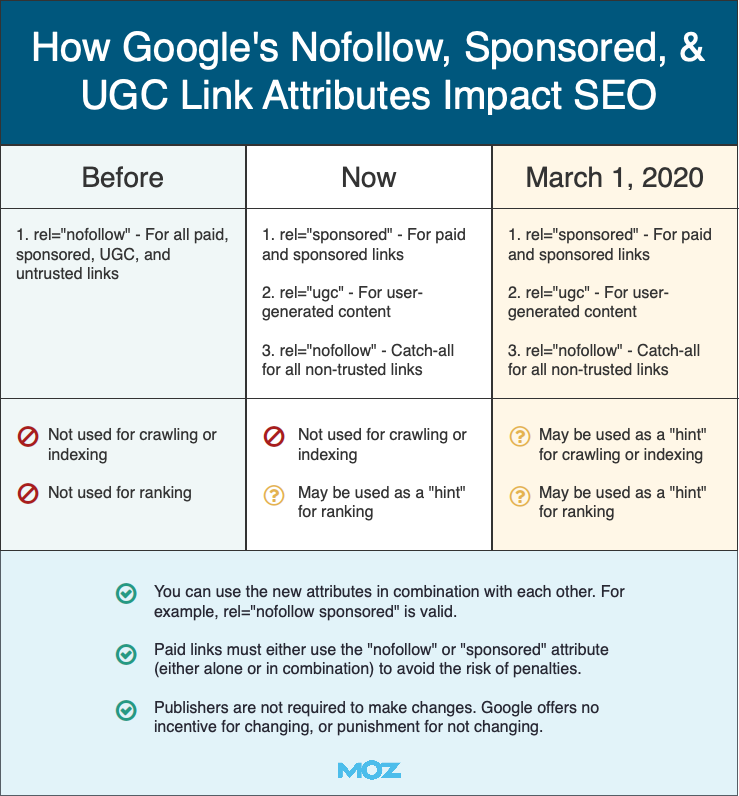Google’s Changing the Game For Digital PR
The 10th September marked good news for those in the combined world of SEO and Digital PR. Google released a news update about upcoming changes to the way that they will be identifying the nature of links, for crawling, indexing and ranking across the web. These are the new changes being put forward to differentiate […]

The 10th September marked good news for those in the combined world of SEO and Digital PR.
Google released a news update about upcoming changes to the way that they will be identifying the nature of links, for crawling, indexing and ranking across the web.
These are the new changes being put forward to differentiate the nature of different links online:
- rel=”sponsored”: This tag will be used to identify links that were created as part of an advertisement, sponsorship or other paid-for agreements.
- rel=”ugc”: This User Generated Content attribute will mostly be used in comment sections and forum posts.
- rel=”nofollow”: This will continue to be used as it is now, for when you don’t want to ‘imply any type of endorsement, including passing along ranking credit to another page.’
The following breakdown from Moz is a helpful indicator to show how the new change will evolve the nofollow tag.

How will this impact Digital PR?
As it currently stands and before this update, Google had implemented little to no ranking factors for all links on the web with the rel=”nofollow tag”. This nofollow tag has existed for almost 15 years and, as mentioned, will continue to be a tag meant for use for any link that you don’t wish to be seen as an endorsement back to the target page.
Links marked with the new tags of sponsored, ugc and nofollow, will now be recognised by Google as ‘hints’ along with their other signals.
Google explain why changes to the way that current nofollow links are being ranked is needed:
“Links contain valuable information that can help us improve search, such as how the words within links describe content they point at. Looking at all the links we encounter can also help us better understand unnatural linking patterns.”
In the era of sponsored and paid content, it is important that we are signalling that 1) there is a difference between a nofollow link and a paid/sponsored link and 2) Instagram is no longer one of the only platforms making changes to identify the difference between sponsored and paid opportunities to its users.
The next steps for those in the SEO and Digital PR industries is to further understand how much ranking ‘worth’ Google will allow for rel=”nofollow” links. More light should be shone on this in March 2020 when the updated will be fully implemented
Kaizen’s Klipr score
At Kaizen we are long-standing believers that whilst nofollow links, in the eyes of Google, had little to no credible value, all links back to our content holds value. Here’s why:
- The quality, relevancy, or length of the coverage. Whether coverage receives a followed link or not, if the website is a perfect fit for the clients’ customers and the central story of our campaign, this proves we are sharing valuable and newsworthy content.
- The high Domain Rating of the website who featured our campaigns. If a website that has been ranked highly by Google, whether that’s DR, DA or TF, and is sharing our campaign or data, this again proves we are creating valuable content. Even without the first-party endorsement of a followed link.
- A publisher adds a link to benefit their story, to give the reader more insight. The fact that the publisher has felt it is relevant to include a backlink to our campaign as a credible source of information is also a bonus for us.
For users of Kaizen’s Klipr platform, not only do we report on follow links, nofollow links, brand mentions, syndicated links, social shares, and average DR (yep, all of that!) we also have a built-in ‘Klipr Score’. This score takes into account the value of followed links, nofollow links and brand mentions and totals these to provide a true score of the impact of the coverage a campaign has received.

 Search
Search PR
PR AI
AI Social
Social














